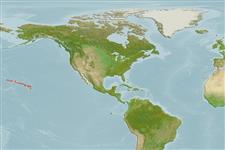>
Dactylopteriformes (Flying gurnards) >
Pegasidae (Seamoths)
Etymology: Eurypegasus: Greek, eurys = long + Greek, Pegasus, pege = springs of Ocean near which Medusa was said to have been killed; the winged horse, sprung from the blood of Medusa (Ref. 45335); papilio: From the Latin word 'pipilio' meaning butterfly..
More on author: Gilbert.
Environment: milieu / climate zone / depth range / distribution range
Οικολογία
Θαλασσινό(ά) βενθικό(ς); εύρος βάθους 80 - 291 m, usually 80 - 115 m (Ref. 58302). Tropical; 28°N - 20°N
Eastern Central Pacific: known only from the Hawaiian Islands.
Μέγεθος / Βάρος / Age
Maturity: Lm ? range ? - ? cm
Max length : 7.6 cm SL αρσενικό/απροσδιόριστο; (Ref. 583)
Ραχιαίες άκανθες (συνολικά): 0; Μαλακές ραχιαίες ακτίνες (συνολικά): 5; Εδρικές άκανθες 0; Μαλακές εδρικές ακτίνες: 5; Σπόνδυλοι: 19. Body color olivaceous to yellow olive dorsally and laterally; whitish ventrally; 3 indistinct, double bands of light red on carapace and tail. Species with 3 pairs of dorsolateral body plates; 4 pairs of ventrolateral body plates; a pair of deep pits on dorsal surface of head; 8 (rarely 9) mobile tail rings; concave suborbital shelf, eyes visible in ventral view. Dorsal and ventral ridges of rostrum almost equally expanded with laterally directed denticles. Medial spine on dorsal surface of last tail ring posteriorly directed.
Inhabits moderately deep water (Ref. 1418). Benthic (Ref. 58302). Larvae and juveniles are often collected in neuston and plankton nets, and midwater trawls (Ref. 1418).
Life cycle and mating behavior
Γεννητική Ωρίμανση | Αναπαραγωγή | Γεννοβολία | Αβγά | Γονιμότητα | Προνύμφες
Palsson, W.A. and T.W. Pietsch, 1989. Revision of the Acanthopterygian fish Family Pegasidae (Order Gasterosteiformes). Indo-Pac. Fish. (18):38 p. (Ref. 1418)
IUCN Red List Status (Ref. 130435)
Threat to humans
Harmless
Human uses
Περισσότερες πληροφορίες
Κοινά ονόματαΣυνώνυμαΜεταβολισμόςΘηρευτέςΟικοτοξικολογίαΑναπαραγωγήΓεννητική ΩρίμανσηΓεννοβολίαΣυναθροίσεις γεννοβολίαςΓονιμότηταΑβγάEgg development
ΑναφορέςΥδατοκαλλιέργειεςΠροφίλ υδατοκαλλιέργειαςΣτελέχοιΓενετικήElectrophoresesΚληρονομικότηταΑσθένειεςΜεταποίησηNutrientsMass conversion
ΣυνεργάτεςΦωτογραφίεςStamps, Coins Misc.ΉχοιΣιγκουατέραΤαχύτηταΚολυμβητικός ΤύποςΕπιφάνεια βραγχίωνOtolithsΕγκέφαλοιΌραση
Εργαλεία
Special reports
Download XML
Διαδικτυακές πηγές
Estimates based on models
Preferred temperature (Ref.
123201): 4.8 - 13.7, mean 6.4 °C (based on 6 cells).
Phylogenetic diversity index (Ref.
82804): PD
50 = 0.7656 [Uniqueness, from 0.5 = low to 2.0 = high].
Bayesian length-weight: a=0.01000 (0.00244 - 0.04107), b=3.04 (2.81 - 3.27), in cm total length, based on all LWR estimates for this body shape (Ref.
93245).
Τροφικό Επίπεδο (Ref.
69278): 3.2 ±0.4 se; based on size and trophs of closest relatives
Fishing Vulnerability (Ref.
59153): Low vulnerability (10 of 100).
